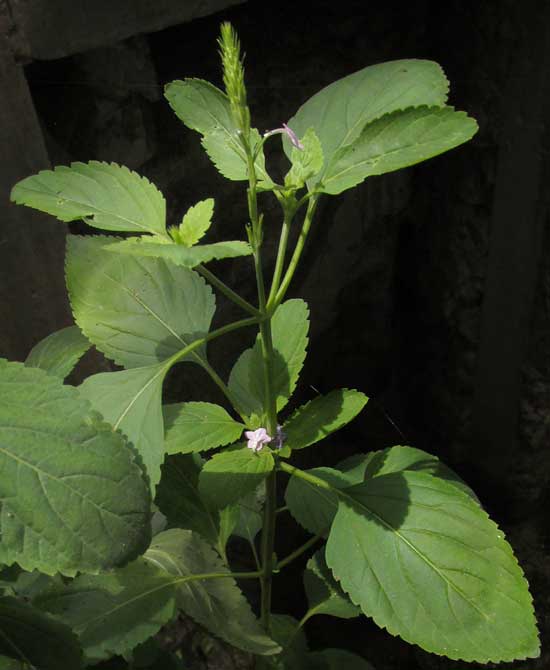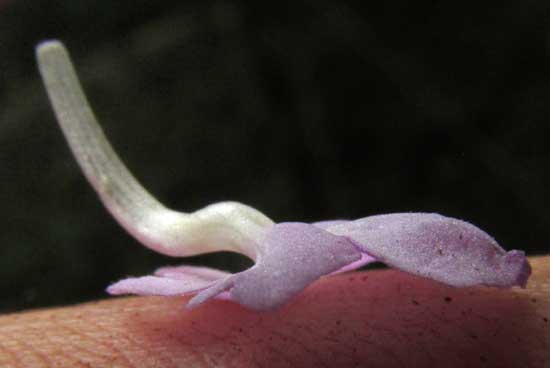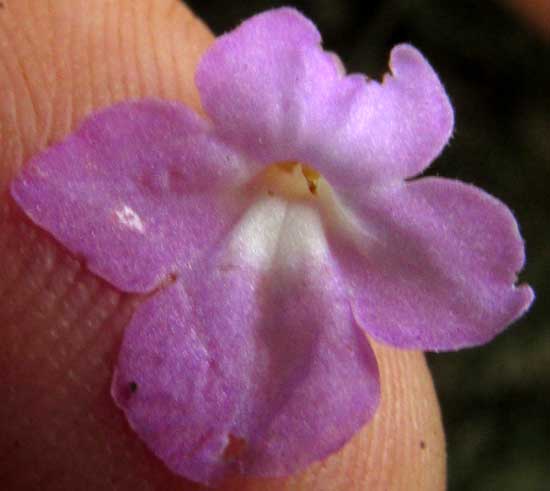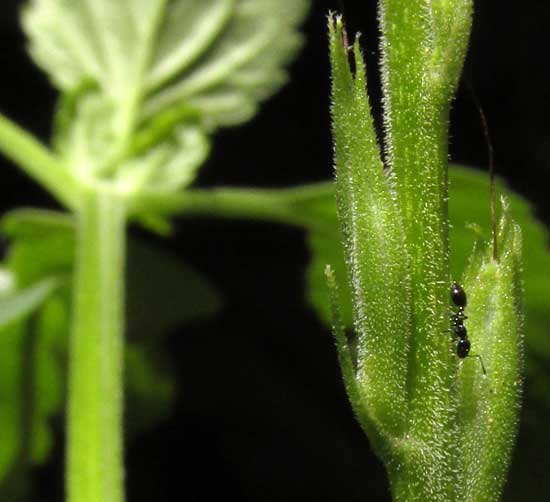Excerpts from Jim Conrad's
Naturalist Newsletter
from the September 10, 2017 Newsletter issued from Rancho Regenesis in the woods ±4kms west of Ek Balam Ruins; elevation ~40m (~130 ft), N20.876°, W88.170°; north-central Yucatán, MÉXICO
BRAZILIAN TEA FLOWERING
At the very rim of the deep pit beside the hut a certain weed emerged at the rainy season's beginning, and this week it started flowering. Below, you can see the herb nicely highlighted against the pit's satiny shadow:

In that picture, the corolla at the bottom was dislodged by a very slight breeze. By dusk, both corollas had fallen, but each morning one or more new flowers are opened, the erect spike at the plant's top flowering from bottom to top.
When you have an herb with squarish stems, which this one has, leaves arising opposite one another, and flowers with bilateral symmetry, your first thought should be that probably you have a member of either the Mint or Verbena Families. This plant's leaves look very minty, but they don't smell minty, plus the corollas' violet color and the flowers being arranged in a slender spike is very typical of the Verbena Family, so at first glance it's not clear which family we have here. Up close you can see that the corollas narrow at their bases into narrow, curved tubes, as shown below:

When that corolla is placed atop a finger, its shape is even more striking, as evidenced below:

A pollinator approaching from the corolla's front finds a nice landing pad and a white splotch at the throat showing where the nectar is -- and yellow, pollen-filled anthers at the top of the tube to dust the pollinator's back as she enters -- as seen below:

Still, it's not really clear which family our herb belongs to until we look at immature fruits at the flowering spike's base, shown on the right, below:

If the fruit were visibly parted into four "nutlets," we'd have a member of the Mint Family, but here you see that the fruits are oblong capsules rounded at their tops, with each top bearing a dark, hairlike, shriveling style -- in the above picture visible a little above and to the right of the ant.
So, this is a member of the Verbena Family, the knowledge of which makes it easy to peg this as STACHYTARPHETA JAMAICENSIS. It's a native plant distributed from Brazil and Ecuador north through Central America to Mexico, and the Caribbean, plus it's cultivated and has gone wild in warmer parts of Africa, Asia and Oceania. Because of its widespread occurrence and use, it's known by several English names, including Brazilian Tea, Blue Porter Weed and Rooter Comb, as well as Gervao, Verbena Cimarrona, and others.
Brazilian Tea is most famous for its traditional medicinal uses. In a 2015 study, Pearl Liew and Yoke Yong at Universiti Putra Malaysia report that a tea made from the plant traditionally is regarded as a cooling tonic that aids in numerous digestive problems, plus it's used to treat allergies and respiratory conditions, from asthma to simple coughs, as well as cirrhosis and hepatitis, and can be applied to clean eternal wounds, ulcers and sores, to boot. Numerous other uses in other parts of the world are described, including helping "female complaints," including restoring the uterus to its original position after childbirth, and to increase milk supply in breast-feeding mothers.
In other words, it's one of those medicinal plants with so many purported uses that you begin doubting the whole list. However, Liew and Yong assayed Brazilian Tea's chemicals and found some powerful ones, including coumarins, flavonoids, tannins and saponins as well as "secondary metabolites" such as alkaloids, phenols, steroids and terpenoids. The researchers conclude that "It is quite evident that S. jamaicensis is an important medicinal plant that plays a vital role in medicinal systems, particularly in traditional and folk medicinal systems," and urge further studie. Their paper is freely available at https://www.hindawi.com/journals/ecam/2016/7842340/
The Maya workers here don't know about Brazilian Tea, but assure me that in Ek Balam there's an herb lady who certainly would. The leaves' bitter/musky smell and taste are about right for a powerfully medicinal herb.